Francesco Albani (1578-1660)
Get a Francesco Albani (1578-1660) Certificate of Authenticity for your painting (COA) for your Francesco Albani (1578-1660) drawing.
For all your Francesco Albani (1578-1660) artworks you need a Certificate of Authenticity (COA) in order to sell, to insure or to donate for a tax deduction.
Getting a Francesco Albani (1578-1660) Certificate of Authenticity (COA) is easy. Just send us photos and dimensions and tell us what you know about the origin or history of your Francesco Albani (1578-1660) painting or drawing.
If you want to sell your Francesco Albani (1578-1660) painting or drawing use our selling services. We offer Francesco Albani (1578-1660) selling help, selling advice, private treaty sales and full brokerage.
We have been authenticating Francesco Albani (1578-1660) and issuing certificates of authenticity since 2002. We are recognized Francesco Albani (1578-1660) experts and Francesco Albani (1578-1660) certified appraisers. We issue COAs and appraisals for all Francesco Albani (1578-1660) artworks.
Our Francesco Albani (1578-1660) paintings and drawings authentications are accepted and respected worldwide.
Each COA is backed by in-depth research and analysis authentication reports.
The Francesco Albani (1578-1660) certificates of authenticity we issue are based on solid, reliable and fully referenced art investigations, authentication research, analytical work and forensic studies.
We are available to examine your Francesco Albani (1578-1660) painting or drawing anywhere in the world.
You will generally receive your certificates of authenticity and authentication report within two weeks. Some complicated cases with difficult to research Francesco Albani (1578-1660) paintings or drawings take longer.
Our clients include Francesco Albani (1578-1660) collectors, investors, tax authorities, insurance adjusters, appraisers, valuers, auctioneers, Federal agencies and many law firms.
Francesco Albani art authentication. Francesco Albani appraisal. Francesco Albani certificates of authenticity (COA). Francesco Albani analysis, research, scientific tests, full art authentications. We will help you sell your Francesco Albani or we will sell it for you.
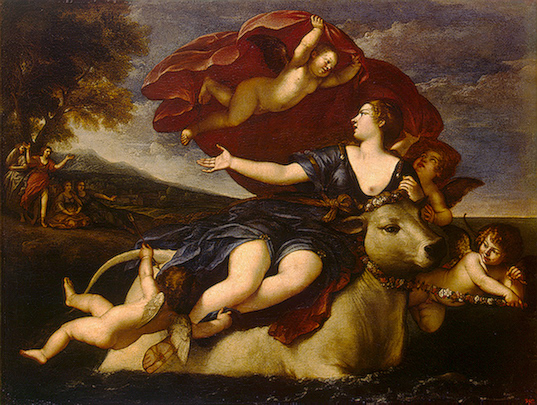
The Rape of Europa 1620-1625
Francesco Albani was an Italian Baroque painter. Born at Bologna, his father was a silk merchant who intended to instruct his son in the same trade; but by age twelve, Albani became an apprentice under the competent mannerist painter Denis Calvaert, where he met Guido Reni. Soon he followed Reni to the so-called “Academy” run by the Carracci family: Annibale, Agostino, and Ludovico. This studio fostered the careers of many painters of the Bolognese school, including Domenichino, Massari, Viola, Lanfranco, Giovanni Francesco Grimaldi, Pietro Faccini, Remigio Cantagallina, and Reni.

The Holy Family 1630-1635
In the year 1600, Albani moved to Rome to work in the fresco decoration of the gallery of the Palazzo Farnese, being completed by the studio of Annibale Carracci. Rome, under Clement VIII Aldobrandini(1592-1605) was exhibiting some degree of administrative stability and renewed artistic patronage. While pope Clement was born from a Florentine family residing in Urbino, his family was allied by marriage to the Emilia-Romagna and the Farnese, since Ranuccio I Farnese, Duke of Parma had married Margherita Aldobrandini. Parma, like Bologna, are part of the Region of Emilia-Romagna. Thus it was not surprise that Cardinal Odoarde Farnese, Ranuccio’s brother, chose the Carraccis from Bologna for patronage, thereby establishing Bolognese predominance of Roman fresco painting for nearly two decades.
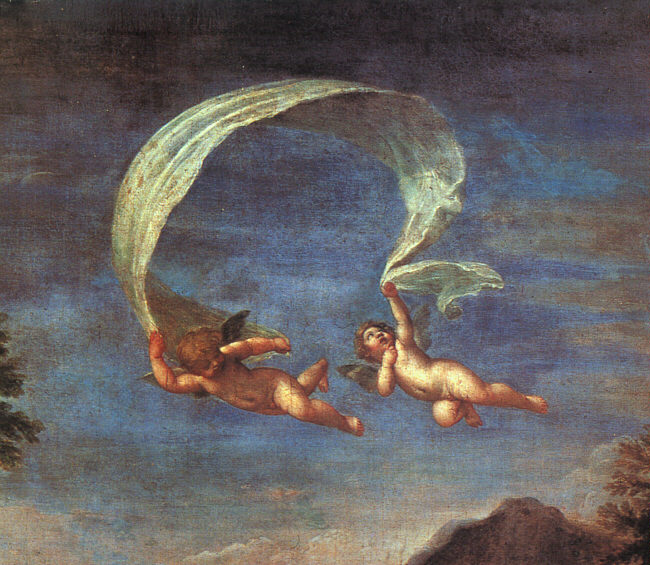
Adonis Led by Cupids to Venus, Detail 1600
Albani became one of Annibale’s most prominent apprentices. Using Annibale’s designs and assisted by Lanfranco and Sisto Badalocchio, Albani completed frescoes for the San Diego Chapel in San Giacomo degli Spagnoli between 1602-1607. In 1606-7, Albani completed the frescoes in the Palazzo Mattei di Giove in Rome. He later completed two other frescoes in the same palace, also on the theme of Life of Joseph.

Ecce Homo
In 1609, he completed the ceiling of a large hall with Fall of Phaeton and Council of the Gods for the Palazzo Giustianini (now Odescalchi) at Bassano (di Sutri) Romano. This work was commissioned by the Marchese Vicenzo Giustiniani, famous for also being patron to Caravaggio.
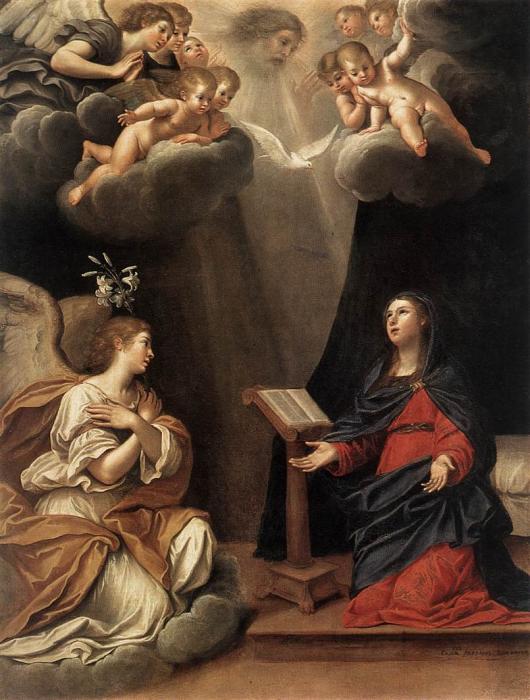
The Annunciation
During 1612-14, Albani completed the Choir frescoes at the newly remodeled (by Pietro da Cortona) church of Santa Maria della Pace. In 1616 he painted ceiling frescoes of Apollo and the Seasons at Palazzo Verospi in Via del Corso for the cardinal Fabrizio Verospi.

Spring 1616-1617
In later years, Albani developed a mutual, though respectful, rivalry with the more successful Guido Reni, who was also heavily patronized by the Aldobrandini, and under whom Albani had worked under at the chapel of the Palazzo del Quirinale.

Winter 1616-1617
Albani’s best fresco masterpieces are those on mythological subjects. Among the best of his sacred subjects are a St Sebastian and an Assumption of the Virgin, both in the church of San Sebastiano fuori le Mura in Rome. He was among the Italian painters to devote himself to painting cabinet pictures. His mythological subjects include The Sleeping Venus, Diana in the Bath, Danaë Reclining, Galatea on the Sea, and Europa on the Bull. A rare etching, the Death of Dido, is attributed to him. Carlo Cignani, Andrea Sacchi, Francesco Mola, and Giovanni Francesco Grimaldi were some of his students. On the death of his wife he returned to Bologna, where he married a second time and resided till his death.
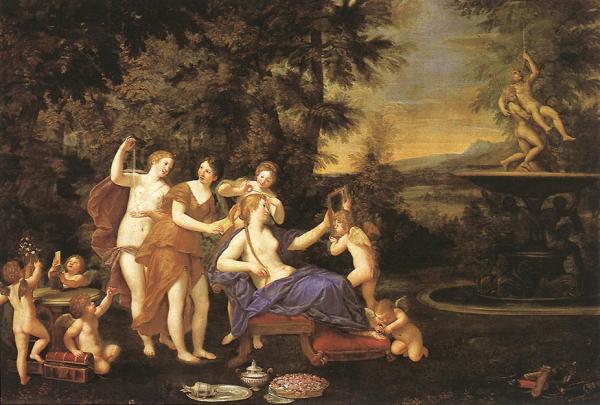
Venus Attended by Nymphs and Cupids 1633
Albani never acquired the monumentality or tenebrism that was quaking the contemporary world of painters, and in fact, is derided often for his lyric, cherubim-filled sweetness, which often has not yet shaken the mannerist elegance. While Albani’s thematic would have appealed to Poussin, he lacked the Frenchman’s muscular drama. His style sometimes appears to befit the decorative Rococo more than of his time.
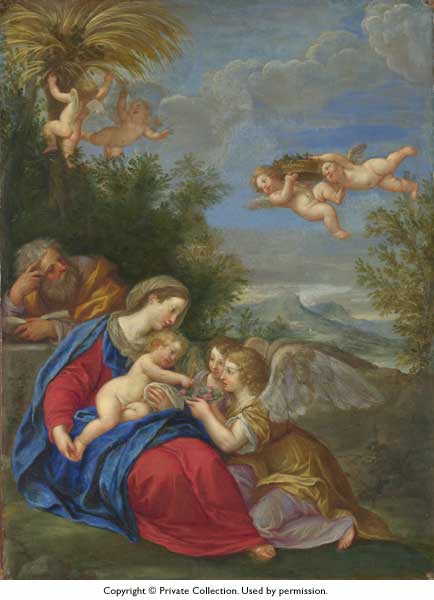
The Rest of the Flight into Egypt
Among the pupils of Albani were his brother Giovanni Battista Albani, and others including Giacinto Bellini, Girolamo Bonini, Giacinto Campagna, Antonio Catalani, Carlo Cignani, Giovanni Maria Galli, Filippo Menzani, Andrea Sacchi, Andrea Sghizzi, Giovanni Battista Speranza, Antonio Maria del Sole, Emilio Taruffi, and Francesco Vaccaro.
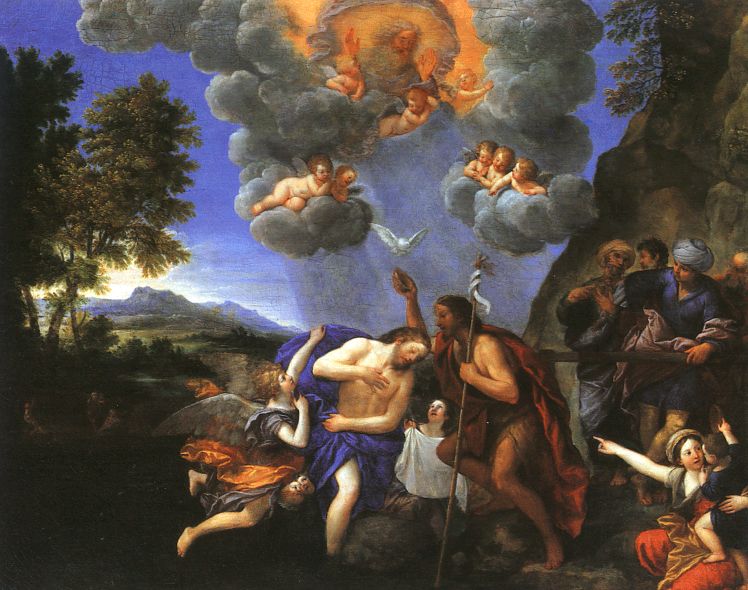
The Baptism of Christ 1640
Major works
• Frescoes in Hall of Aeneas -Palazzo Fava, Bologna
• Frescoes in Oratory of San Colombano – Bologna
• Frescoes in Hall of Aeneas (1601-1602) – Palazzo Doria Pamphilj, Rome
• Frescoes for San Giacomo degli Spagnoli (1602-1607) – Museo del Prado and in Museum of Barcelona
• Holy Family with Angels (1608-1610) – MFA, Boston
• Allegorical canvases of the seasons Spring,Summer,Fall and Winter (1616-1617) – Galleria Borghese, Rome
• Baptism of Christ (c. 1620) – Oil on canvas, 428.5 x 224.5 cm, Pinacoteca Nazionale di Bologna
• Diana and Actaeon (1625-1630) – Oil on wood transferred to canvas, 74,5 x 99,5 cm, Gemäldegalerie, Dresden
• Four Elements (1628-1630) – Pinacoteca, Turin
• Holy Family (1630-1635) – Oil on canvas, 57 x 43 cm, Palazzo Pitti, Florence
• Self-Portrait (c. 1630) – Oil on canvas, 75 x 59.5 cm, Pinacoteca Nazionale di Bologna
• Venus Attended by Nymphs and Cupids (1633) -Oil on canvas, 114 x 171 cm, Prado, Madrid)[1] • Annunciation (1633) – Chiesa di S.Bartolomeo, Bologna
• The Annunciation – Oil on copper, 62 x 47 cm, Hermitage, St. Petersburg[2] • Madonna with Child in Glory with Sts. Jerome and Francis (c. 1640) – oil on copper, 43.5 x 31.8 cm, Pinacoteca Nazionale di Bologna
• The Baptism of Christ (c. 1640) – Oil on canvas, 268 x 195 cm, Hermitage, St. Petersburg
• The Rape of Europa (c. 1640-1645) – Oil on canvas, 170 x 224 cm, Hermitage, St. Petersburg
• Annunciation (c. 1640-1645) – Oil on copper, 62 x 47 cm, Hermitage, St. Petersburg
• The Holy Women at Christ’s Tomb (1640s-1650s) – Oil on canvas, 170 x 224 cm, Hermitage, St. Petersburg
• Danza degli amorini – Pinacoteca di Brera, Milan
• Tondo Borghese – Galleria Borghese, Rome
• Tasso’s landscapes – Galleria Colonna, Rome
• ‘Frescoes – Chiesa di Santa Maria di Galliera
Works at the Louvre, Paris
• Acteon Metamorphosis into Hind
• Adonis led by Cupids to Venus (1600)
• Diana and Acteon and Venus and Adone
• Apollo and Daphne
• The Bath of Venus
• Christ appears to Mary Magdalen
• Rest of Venus
• Holy Father and Archangel Gabriel
• Venus disarms Cupids
• Saint Francis of Assisi before Crucifix
• Salmacis and Hermaphrodite
• Nativity
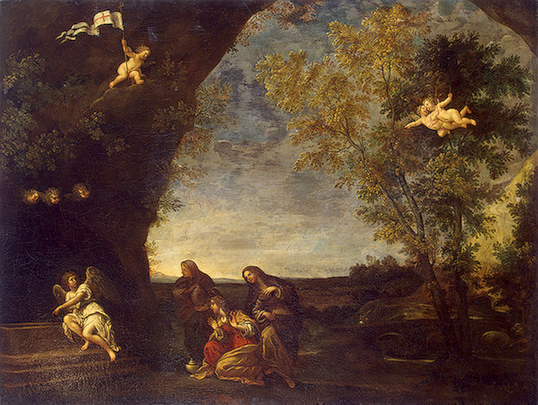
The Holy Women at Christs Tomb, 1640’s-1650’s
Reviews
1,217 global ratings
5 Star
4 Star
3 Star
2 Star
1 Star
Your evaluation is very important to us. Thank you.
